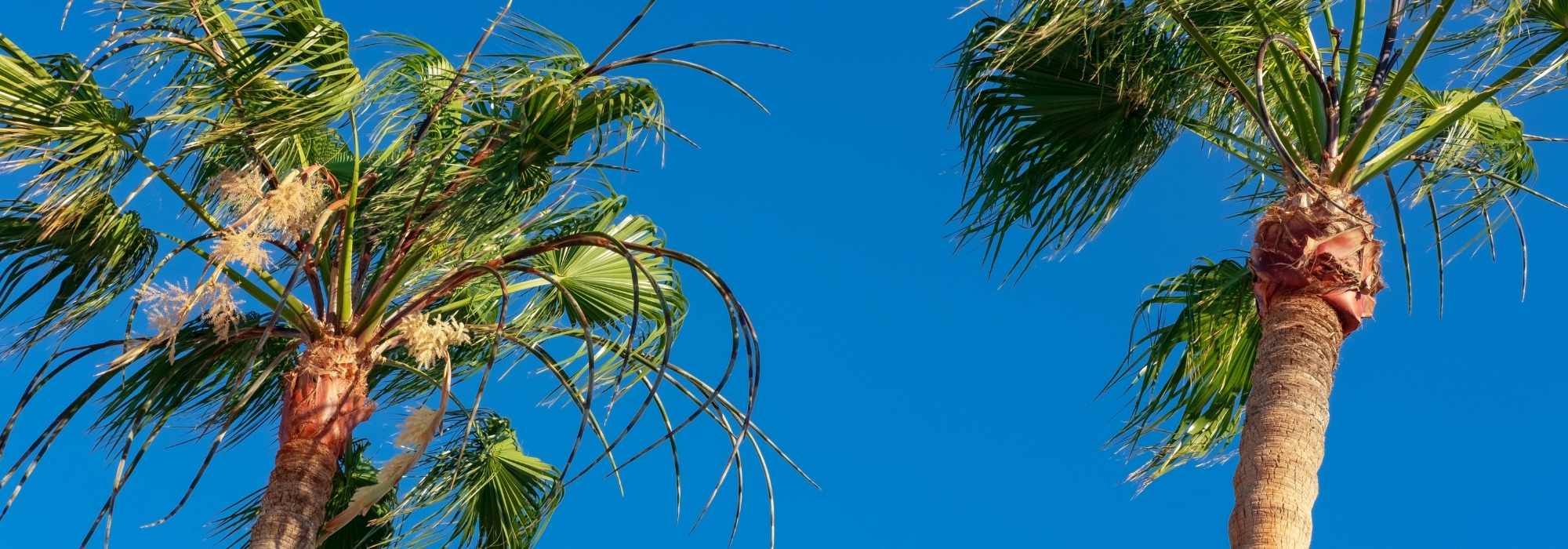
Copernicia : planting, maintenance
Contents
The Copernicia in a nutshell
- It ranks among the most beautiful ornamental palms!
- It unfurls a crown of large and stunning fan-shaped leaves
- Being sensitive to cold, it requires plenty of sunlight and warmth to thrive
- It can only be grown in the ground in mild climates; elsewhere, it should be potted and sheltered indoors during winter
- It’s a top choice for a southern garden or a star plant for the terrace!
The word from our expert
The Copernicia is a stunning palm tree, remarkable for the beauty of its crown of large, plicate fan-shaped leaves. It owes its nickname, the “Wax Palm”, to the waxy substance that covers its foliage, from which carnauba wax is extracted for food or cosmetic use. The Copernicia can grow up to 20 metres in height, though some species, such as the Copernicia hospita, do not exceed 7 metres.
Native to South America, this palm is a very tender plant that thrives in sun and warmth.
While it can only be grown in the ground along a narrow coastal strip of the Mediterranean or Atlantic coastline, in colder regions, it will also thrive in a large container to decorate the terrace during the warmer months and be moved to a conservatory in winter. The Copernicia alba is somewhat of an exception, as it has the advantage of being hardier than other species, withstanding temperatures down to -7°C in dry soil.
Provide it with a sunny, sheltered spot away from prevailing winds, rich, well-drained soil that remains moist in summer and drier in winter. Once established, it will require little attention.
Discover this magnificent palm tree for mild gardens or to add an exotic touch to your terrace anywhere else!
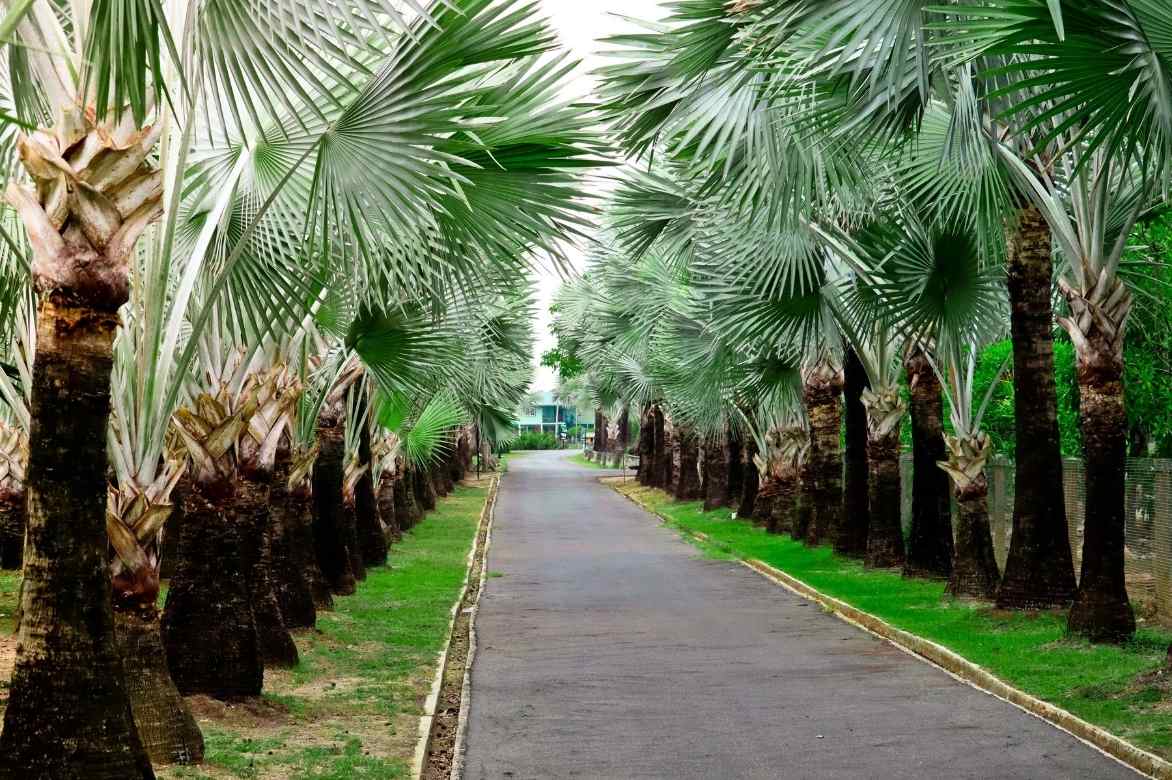
Avenue lined with Copernicia baileyana
Description and Botany
Botanical data
- Latin name Copernicia
- Family Arecaceae
- Common name Wax palm
- Flowering summer
- Height 5 to 20 m
- Exposure Sun
- Soil type Rich, moist, well-drained
- Hardiness frost-sensitive
The Copernicia, commonly known as the “wax palm”, belongs to the vast Arecaceae family, which includes palm trees. The genus comprises 22 species and hybrid varieties native to the savannas and forests of South America, Cuba, Argentina, Brazil, and Bolivia. In cultivation, in our gardens, we encounter the Copernicia alba, the only species capable of withstanding temperatures as low as -7°C. This is why this palm tree can only be grown outdoors in the mildest gardens of our country, along the Mediterranean or southern Atlantic coast. Elsewhere, it can be cultivated in a very large pot to adorn the terrace during the summer and indoors in winter. The Copernicia hospita is another beautiful but frost-sensitive species, best grown in a large pot to protect it from winter frosts.
This palm tree is rather slow to establish. The height varies greatly depending on the species. The Copernicia can reach heights of 5 to 20 m with a spread of 4 to 7 m in the wild or in open ground. When grown in pots, it remains more compact.
In this palm, the trunk or stipe is solitary. It can measure up to 40 cm in diameter at its minimum in its natural habitat. In our latitudes, it remains quite narrow, light brown-grey in colour, smooth or fibrous, and, like all palm trees, it is marked by the scars of old petioles. In some older specimens, these foliar remnants create a particularly graphic honeycomb pattern. The very dense and resistant stipe is used for making utility poles.
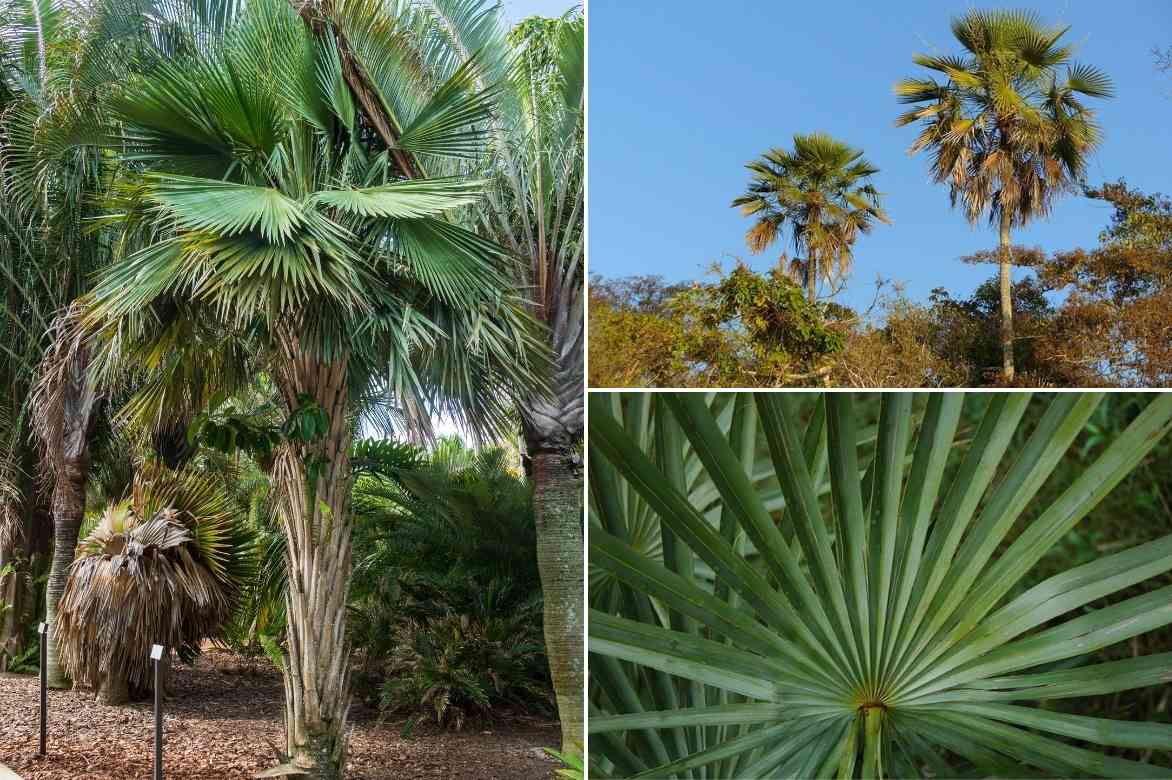
Copernicia hospita and alba
At its summit, a crown of large evergreen leaves unfolds, keeping the plant attractive all year round. The foliar crown consists of a cluster that can include over 40 leaves or fronds with pleated leaflets, resembling a fan. These are rigid, tough, rounded, or perfectly circular, and can exceed 1.50 m in width in the largest specimens. They are attached to the stipe by a thick, long petiole armed with sharp black spines.
They have a grey-green or whitish colour and a glossy appearance due to the waxy coating that covers them, hence its other name, “Wax Palm”. Each leaf has a lifespan of several years.
The flowering is rare in cultivation and only appears in summer on mature specimens. It varies by species and takes the form of inflorescences in panicles or spadices of generally yellow or brown flowers. Some species are monoecious, with hermaphroditic flowers that are both male and female, while others are dioecious, meaning there are male and female plants, requiring both genders for the palm to bear fruit.
These small flowers are followed by small, round black fruits measuring 2.5 cm in diameter.
The leaves of the Copernicia prunifera species yield carnauba wax, the hardest of all vegetable waxes. It is, for example, one of the main ingredients in surf wax but is also used in the food, cosmetic, and pharmaceutical industries.
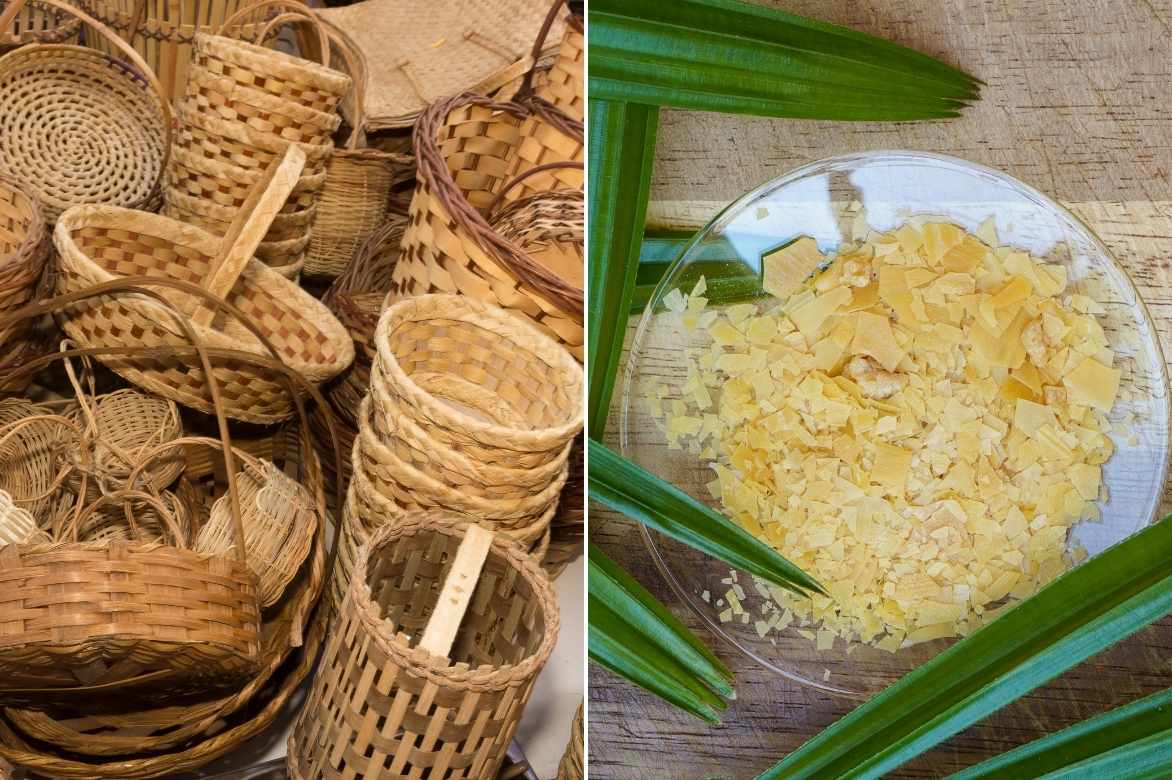
Baskets and carnauba wax
Main species and varieties
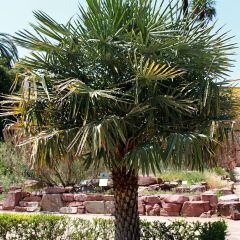
Copernicia alba - Caranda Palm
- Flowering time August
- Height at maturity 20 m
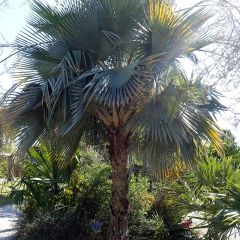
Copernicia hospita - Caranda Palm
- Flowering time August
- Height at maturity 7 m
Discover other Copernicia
View all →Available in 1 sizes
Available in 1 sizes
Planting the Copernicia
Where to Plant It?
Like most palm trees, the Copernicia requires plenty of sunlight. Frost-sensitive, it can only be planted in the ground in mild climates (orange tree zone), as it perishes below -2°C. Plant it in a sheltered spot to protect it from the cold in winter. This is why in colder regions, it must be grown in a large pot and moved to a frost-free location.
In the ground, it thrives in any light, well-drained soil, rich in compost, remaining moist in summer and rather dry in winter. Adaptable, it will tolerate occasional short periods of drought or waterlogged soil in spring and summer. However, in winter, it will fare better in well-drained soil that does not retain water: ensure proper drainage during planting.
Choose the location for your palm tree carefully, as it dislikes being moved once well-rooted due to its brittle and fragile roots.
In mild gardens, it fits perfectly at the centre of an exotic flower bed in full sun, as a standalone feature on a short grass meadow, or in a large container near a swimming pool.
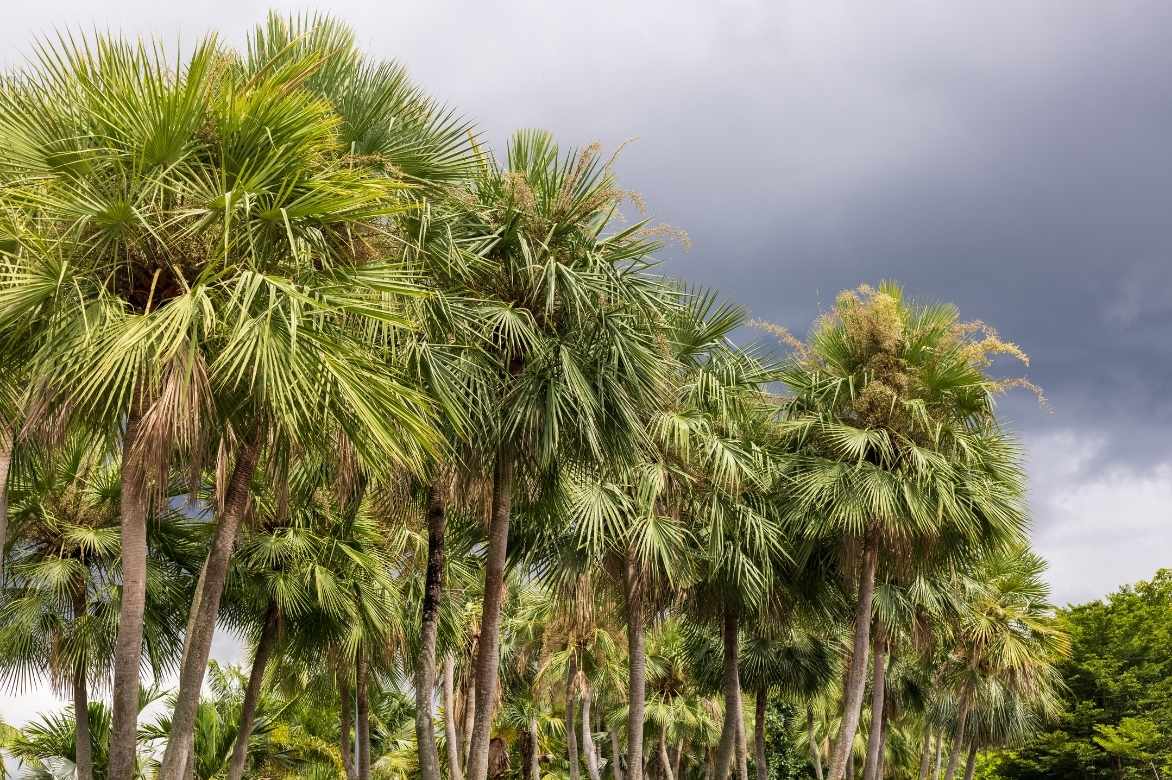
Copernicia prunifera
When to Plant It?
Planting the Copernicia in the garden should be done in spring, from March to June after the frosts, as it needs warmth to establish well.
How to Plant It?
In the Ground
Choose a sunny location with enough space for it to grow comfortably. If your soil tends to retain water, improve drainage by adding coarse sand or gravel during planting. You can also plant your palm tree on a mound to allow water to drain easily.
- Prepare a large hole, 2 to 3 times the size of the root ball
- Spread a layer of gravel or clay pebbles at the bottom of the planting hole
- Plant the palm tree in the centre of the hole
- Fill with a mixture of turf, garden soil, and sand
- Avoid burying the base of the trunk
- Water thoroughly
- Mulch around the base to keep the soil moist
In a Pot
This palm tree grows very well in a large pot, which can be placed on the terrace in summer and moved to a frost-free location in winter in less temperate regions.
- Choose a large pot with drainage holes, with a capacity of 75 to 100 litres
- Spread a drainage layer at the bottom of the pot (clay pebbles, gravel, broken terracotta pots, etc.)
- Prepare a mixture of 50% garden soil, 25% ordinary compost, and 25% sand, and fill the pot partially
- Place the palm tree on the mixture, without burying the base of the trunk too deeply
- Fill in with the remaining mixture, firming it around the root ball
- Water generously
How to care for the Copernicia?
In the Ground
The Copernicia requires little maintenance once well established. In the first few years, it will need regular watering, especially during prolonged dry spells, as it prefers soil that remains cool in summer. Apply mulch around the base to keep its roots cool and reduce the need for watering.
Each year, lightly work some compost into the soil around the base in spring to support growth.
If cold weather is forecast, wrap its fronds in burlap or winter fleece. Young plants can be mulched at the base with dead leaves or gravel before the cold arrives to help them survive the winter.
In spring and summer, you can prune the oldest and damaged fronds back to the trunk. Wear thick gloves, as the thorns on the petioles are unforgiving!
In a Pot
Water approximately once a week during the growing season, allowing the substrate to dry out between waterings to prevent root rot.
Feed it with organic fertiliser for green plants once a month from April to September. Wrap its fronds in winter fleece and protect the pot with cardboard or bubble wrap if you plan to leave it outside during winter.
If you live in a cooler climate, we recommend protecting it for winter: move the pot to a sheltered, bright room. Reduce watering in winter to once a week and stop fertilising altogether.
Once the risk of frost has passed, you can gradually reintroduce your palm to the outdoors, acclimatising it to sunlight.
If the roots are emerging from the pot, it’s time to repot. Do this every three years or so in spring, replanting your palm in a slightly larger pot and taking care not to damage the fragile roots. For larger specimens that are difficult to repot, you can simply replace the old substrate on the surface with fresh material, about 4 cm deep. Be cautious of the thorns when tending to your palm!
Diseases and Parasites of Copernicia
In our territory, certain pests threaten large palm trees such as the Copernicia. Among them, there are two main ones:
- The Paysandra archon, a large butterfly whose caterpillars infiltrate the heart of the trunk to feed on it, eventually damaging the leaves and causing defoliation.
→ Read more on the subject: “The palm tree butterfly, Paysandisia archon: control and treatment”
- The red palm weevil (Rhynchophorus ferrugineus), whose larvae attack the heart of the trunk and the leaves, which eventually dry out, leading to the certain death of the palm tree. In case of an attack, it is obligatory to report their presence to the town hall. It is a real scourge in the PACA region for palm trees grown in open ground, hence its nickname “palm tree killer”. The larvae of this beetle, originating from Southeast Asia, have been contaminating the entire south of France since 2006.
To learn more, read our advice sheet: How to combat the red palm weevil.
Indoors, red spider mites can threaten the foliage if the atmosphere is too hot, poorly ventilated, and dry: to dislodge them, regularly mist the foliage, as they detest humidity.

Copernicia macroglossa
Multiplication
You can propagate the Copernicia by sowing in spring, provided it has fruited and you have harvested seeds. This is a lengthy and relatively tedious process, best suited for experienced gardeners. The seeds should be sown warm after soaking. After sowing the seeds on a layer of compost and vermiculite, place your seedlings in a heated greenhouse at 20-25°C. Keep moist until germination, which takes about 2 months. Transplant into buckets and then keep warm throughout the winter, protected from frost. Transplant into the garden or into pots the following spring when the seedlings are robust enough.
Pair
Majestic with its slender trunk and graphic fronds, the mere presence of a Copernicia in a garden is often enough to create an exotic atmosphere! It is invaluable for creating a unique, faraway focal point, paired with other palms such as the Yucca, the Phoenix, or other banana plants like the Musa basjoo.
It will easily become the centrepiece within a bed of tropical-looking plants where the soil retains some coolness in summer. For a stunning exotic scene, surround it with the warm-toned flowering of Crocosmias, Kniphofias, Eucomis, or Cannas, or with Mediterranean perennials such as the Jerusalem Sage or the Agastache ‘Kudos Coral’.
In a more subdued composition, in mild climates, plant at its base plants with remarkable graphic appeal such as Dasylirion, Cordylines, Beschorneria, Phormium, and agaves.
In pots, it will thrive alongside mimosas or the Strelitzia reginae or paired with a small palm like the Chamaedorea near a pool, for example, in an exotic-inspired setting.
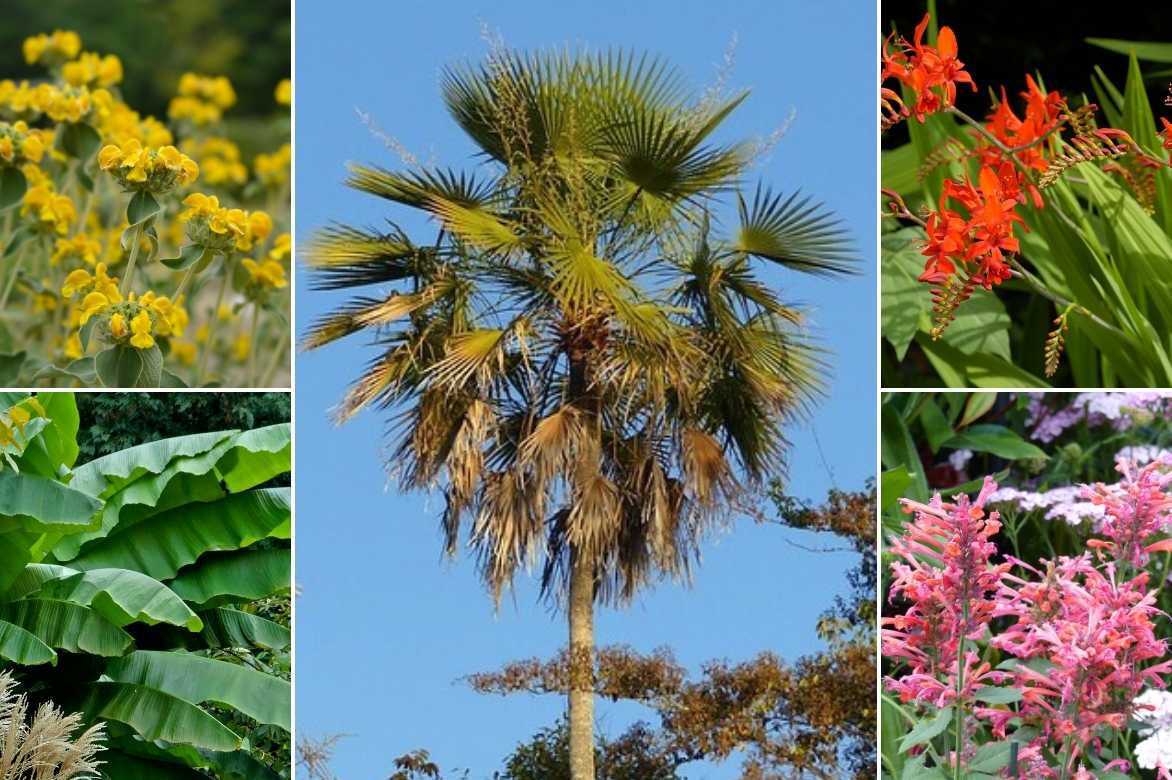
Copernicia alba alongside Phlomis, banana plants, Crocosmias, and Agastache Kudos Coral
Useful resources
- To learn everything about palm trees, check out our comprehensive guide: “Palm Trees: Planting, Growing, and Caring”
- Our article: “Which Palm Tree Should I Choose for My Garden?”
- Discover our full range of palm trees.
- Our advice sheet: “Palm Trees by Climate”
- Subscribe!
- Contents

































Comments